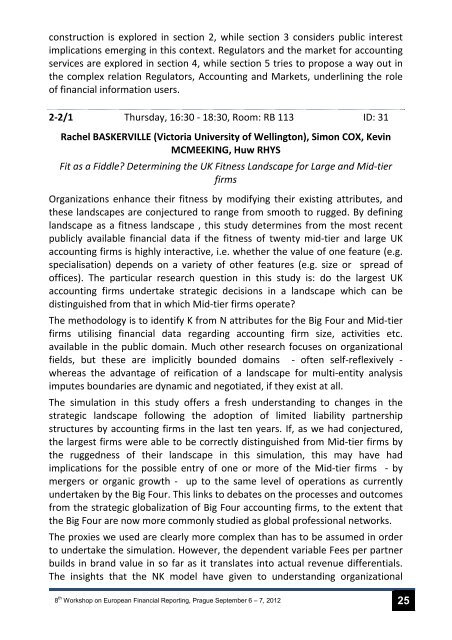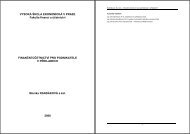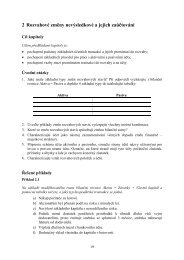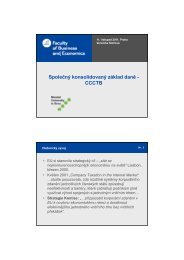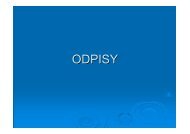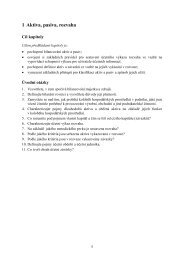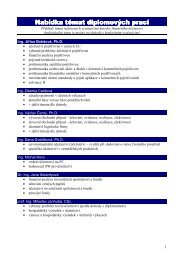on what is reported, and add their own judgments. What is anchored on shouldbe clear and reliable. The residual income approach to valuation (RIV) is basedon accounting figures, and is a demonstration of how this functions. The basicnormative question is whether financial accounting does have meaning, or not.RIV offers confirmation I a positive direction. For practitioners this is lessinteresting. They are more concerned about how accounting is done, and thisleads to the normative problem of what is good or less good accounting. So faranswers are less definitive. However, RIV may offer some clues. In discussingthis, work of Stephen Penman has been a great inspiration.2-1/2 Thursday, 16:30 - 18:30, Room: RB 112 ID: 47Christoph PELGER (University of Cologne)Decision-making on stewardship: An analysis of the standard-setters process ofidentifying the objective of financial reportingIn their joint project to create a revised conceptual framework, IASB and FASBdecided to define valuation usefulness as the single objective of financialreporting while neglecting stewardship usefulness. This paper addresses thequestion why the standard-setters decided that way. The method employed is aprocess analysis of standard-setting in the case of accounting objectivesincluding a comprehensive (content) analysis of all documents available from thedue process. It results that the supremacy of valuation usefulness mainly followsfrom the preferences of US board members. Despite a large opposition fromconstituents and some board members, this group was able to establish itsposition due to assistance from the staff and obvious differences in the balancesof power that were reinforced by the pending decision of the SEC on IFRSadoption and the lack of a consistent (alternative) stewardship world-view forfinancial reporting.2-1/3 Thursday, 16:30 - 18:30, Room: RB 112 ID: 48Stefania SERVALLI (University of Bergamo (Italy)), David ALEXANDERHow to improve the accounting regulation: it is the users, stupidThe macro-accounting regulation, relating to the function of allocating economicresources in the capital market, by influencing the investors decision-making(Oguri 2005, p.90) influences macro-societal policies, such as the ones referredto taxation, to wage bargaining, and, more in general, to economicrestructuration (Chua, 1986, p.623).In a globalized world, this kind of regulation has become more relevant, givingway towards a global macro-accounting regulation, with a consequentmovement beyond the State and its institutions. The accounting as social24 8 th Workshop on European Financial Reporting, Prague September 6 – 7, <strong>2012</strong>
construction is explored in section 2, while section 3 considers public interestimplications emerging in this context. Regulators and the market for accountingservices are explored in section 4, while section 5 tries to propose a way out inthe complex relation Regulators, Accounting and Markets, underlining the roleof financial information users.2-2/1 Thursday, 16:30 - 18:30, Room: RB 113 ID: 31Rachel BASKERVILLE (Victoria University of Wellington), Simon COX, KevinMCMEEKING, Huw RHYSFit as a Fiddle? Determining the UK Fitness Landscape for Large and Mid-tierfirmsOrganizations enhance their fitness by modifying their existing attributes, andthese landscapes are conjectured to range from smooth to rugged. By defininglandscape as a fitness landscape , this study determines from the most recentpublicly available financial data if the fitness of twenty mid-tier and large UKaccounting firms is highly interactive, i.e. whether the value of one feature (e.g.specialisation) depends on a variety of other features (e.g. size or spread ofoffices). The particular research question in this study is: do the largest UKaccounting firms undertake strategic decisions in a landscape which can bedistinguished from that in which Mid-tier firms operate?The methodology is to identify K from N attributes for the Big Four and Mid-tierfirms utilising financial data regarding accounting firm size, activities etc.available in the public domain. Much other research focuses on organizationalfields, but these are implicitly bounded domains - often self-reflexively -whereas the advantage of reification of a landscape for multi-entity analysisimputes boundaries are dynamic and negotiated, if they exist at all.The simulation in this study offers a fresh understanding to changes in thestrategic landscape following the adoption of limited liability partnershipstructures by accounting firms in the last ten years. If, as we had conjectured,the largest firms were able to be correctly distinguished from Mid-tier firms bythe ruggedness of their landscape in this simulation, this may have hadimplications for the possible entry of one or more of the Mid-tier firms - bymergers or organic growth - up to the same level of operations as currentlyundertaken by the Big Four. This links to debates on the processes and outcomesfrom the strategic globalization of Big Four accounting firms, to the extent thatthe Big Four are now more commonly studied as global professional networks.The proxies we used are clearly more complex than has to be assumed in orderto undertake the simulation. However, the dependent variable Fees per partnerbuilds in brand value in so far as it translates into actual revenue differentials.The insights that the NK model have given to understanding organizational8 th Workshop on European Financial Reporting, Prague September 6 – 7, <strong>2012</strong> 25
- Page 1: The 8 th Workshop onEuropean Financ
- Page 6: 6 8 th Workshop on European Financi
- Page 10 and 11: Time ScheduleThursday, September 6R
- Page 12 and 13: Plenary SessionFinancial reporting
- Page 14 and 15: Thursday, 16:30 - 18:30RoomRB 112Ch
- Page 16 and 17: Collected Abstracts1-1/1 Thursday,
- Page 18 and 19: 1-2/1 Thursday, 14:00 - 16:00, Room
- Page 20 and 21: Seldom JVs "comprise a major part -
- Page 22 and 23: eporting segments) compared to comp
- Page 26 and 27: ehaviour and choices in strategic d
- Page 28 and 29: lower analysts forecast dispersion.
- Page 30 and 31: of an online survey between German
- Page 32 and 33: 2-5/3 Thursday, 16:30 - 18:30, Room
- Page 34 and 35: implications for the IASB as it del
- Page 36 and 37: funded by owners equity. Using diff
- Page 38 and 39: 3-4/1 Friday, 9:00 - 11:00, Room: R
- Page 40 and 41: in an attempt to furnish a solution
- Page 42 and 43: 18. EVANS Lisa, University of Stirl
- Page 44 and 45: 51. NEDVIDEK Vaclav, VSE, Czech Rep
- Page 46: Notes46 8 th Workshop on European F


